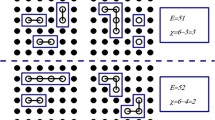Abstract
We study the quantum self-organization of interacting particles in one-dimensional (1D) many-body systems, modeled via Hubbard chains with short-range interactions between the particles. We show the emergence of 1D states with density-wave and clustering order, related to topology, at odd denominator fillings that appear also in the fractional-quantum-Hall-effect (FQHE), which is a 2D electronic system with Coulomb interactions between the electrons and a perpendicular magnetic field. For our analysis, we use an effective topological measure applied on the real space wavefunction of the system, the Euler characteristic describing the clustering of the interacting particles. The source of the observed effect is the spatial constraints imposed by the interaction between the particles. In overall, we demonstrate a simple mechanism to reproduce many of the effects appearing in the FQHE, without requiring a Coulomb interaction between the particles or the application of an external magnetic field.
Graphic Abstract






Similar content being viewed by others
Data Availability Statement
This manuscript has no associated data or the data will not be deposited. [Authors’ comment: All the numerical data from our calculations are displayed/plotted inside the figures.].
References
F.D.M. Haldane, Phys. Rev. Lett. 45, 1358 (1980)
F.D.M. Haldane, Phys. Lett. A 93, 464 (1983a)
I. Affleck, T. Kennedy, E.H. Lieb, H. Tasaki, Phys. Rev. Lett. 59, 799 (1987)
M. Levin, X.-G. Wen, Phys. Rev. Lett. 96, 110405 (2006)
X. Chen, Z.-C. Gu, X.-G. Wen, Phys. Rev. B 82, 155138 (2010)
A. Kitaev, J. Preskill, Phys. Rev. Lett. 96, 110404 (2006)
A.Y. Kitaev, Ann. Phys. 303, 2 (2003)
V. Alba, M. Fagotti, P. Calabrese, J. Stat. Mech. 0910, P10020 (2009)
V. Alba, M. Haque, M. Luchli, Phys. Rev. Lett. 110, 260403 (2013)
I. Hen, M. Rigol, Phys. Rev. B 80, 134508 (2009)
A. Hamma, R. Ionicioiu, P. Zanardi, Phys. Rev. A 71, 022315 (2005)
P. Calabrese, A. Lefevre, Phys. Rev. A f78, 032329 (2008)
F. Pollmann, A.M. Turner, E. Berg, M. Oshikawa, Phys. Rev. B 81, 064439 (2010)
L. Amico, R. Fazio, A. Osterloh, V. Vedral, Rev. Mod. Phys. 80, 517 (2008)
R. Horodecki, P. Horodecki, M. Horodecki, K. Horodecki, Rev. Mod. Phys. 81, 865 (2009)
D.C. Tsui, H.L. Stormer, A.C. Gossard, Phys. Rev. Lett. 48, 1559 (1982)
E.B. Laughlin, Phys. Rev. Lett. 50, 1395 (1983)
H.L. Stormer, D.C. Tsui, A.C. Gossard, Rev. Mod. Phys. 71(S298), S305 (1999)
H. Li, F.D.M. Haldane, Phys. Rev. Lett. 101, 010504 (2008)
F.D.M. Haldane, Phys. Rev. Lett. 107, 116801 (2011)
I. Kleftogiannis, I. Amanatidis, Eur. Phys. J. B 93, 84 (2020)
I. Kleftogiannis I, I. Amanatidis , V. Popkov, J. Stat. Mech. 063102 (2019)
B. Chen, G. Chen, Gauss–Bonnet formula, Finiteness condition, and characterizations for graphs embedded in surfaces. Graphs Combin. 24(3), 159–183 (2008)
O. Knill, A discrete Gauss-Bonnet type theorem. Elem. Math. 67, 1–17 (2012)
O. Knill, A graph theoretical Gauss–Bonnet–Chern theorem (2011). arXiv:1111.5395
I. Kleftogiannis, I. Amanatidis, Eur. Phys. J. B 92, 198 (2019)
I. Kleftogiannis, I. Amanatidis, J. Stat. Mech. 083108 (2020)
W. Pan, J.S. Xia, H.L. Stormer, D.C. Tsui, C. Vicente, E.D. Adams, N.S. Sullivan, L.N. Pfeiffer, K.W. Baldwin, K.W. West, Phys. Rev. B 77, 075307 (2008)
W.P. Su, J.R. Schrieffer, Phys. Rev. Lett. 46, 738 (1980)
E.J. Bergholtz, A. Karlhede, Phys. Rev. B 77, 155308 (2008)
H. Guo, S.Q. Shen, S. Feng, Phys. Rev. B 86, 085124 (2012)
M.I. Dyakonov, J. Phys. Conf. Ser. 456, 012008 (2013)
R. Pankaj, S. Yarlagadda, Phys. Rev. B 86, 035453 (2012)
A. Ghosh, S. Yarlagadda, Phys. Rev. B 90, 045140 (2014)
G. Timp, R. Behringer, J.E. Cunningham, R.E. Howard, Phys. Rev. Lett. 63, 2268 (1989)
Acknowledgements
We acknowledge resources and financial support provided by the National Center for Theoretical Sciences of R.O.C. Taiwan and the Department of Physics of Ben-Gurion University of the Negev in Israel. Also we acknowledge support by the Project HPC-EUROPA3 (INFRAIA-2016-1-730897), funded by the EC Research Innovation Action under the H2020 Programme. In particular, we gratefully acknowledge the computer resources and technical support provided by ARIS-GRNET and the hospitality of the Department of Physics at the University of Ioannina in Greece.
Author information
Authors and Affiliations
Corresponding author
Rights and permissions
About this article
Cite this article
Kleftogiannis, I., Amanatidis, I. Fractional-quantum-Hall-effect (FQHE) in 1D Hubbard models. Eur. Phys. J. B 94, 41 (2021). https://doi.org/10.1140/epjb/s10051-021-00050-w
Received:
Accepted:
Published:
DOI: https://doi.org/10.1140/epjb/s10051-021-00050-w




